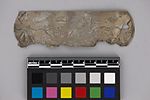Cross ? Fragment
About this object
History of use
Silver ornaments represent an important part of early exchange between Europeans, including fur traders, and first nations people, especially in Eastern and Central Canada and the USA. Initially, the main sources of silver were British, French, and Spanish coins. Most ornaments were produced by silversmiths of European origin in North America and Europe, and were actively traded only from 1760 to 1821. By the mid-18th century silver objects were produced in New England, Quebec and Montreal. Silver was used by first nations people as a sign of rank. Silver ornaments in these styles continue to be produced by native silversmiths in Central Canada and the USA. The cross was the oldest form of trade silver, introduced by French missionaries to North America for presentation to converts. Crosses were later used as trade silver with no religious connotations. They circulated well into the 19th century, and were worn on the chest.
Cultural context
trade; personal ornamentation; political alliance
Specific techniques
Roulette engraving produces a uniform zigzag, an identifying feature of the technique, and is created by using a revolving disk with sharp teeth.
Physical description
Fragment, probably part of a cross, decorated with curvilinear zigzag lines. Two holes cut in one end.
Categories
Materials
Date Made
1760-1828
Date Acquired
9 Sep 1993
How Acquired
Donated
Credit Line
Measurements
Overall: 10.7 cm x 3.4 cm x .4 cm
Object Number
1590/5
